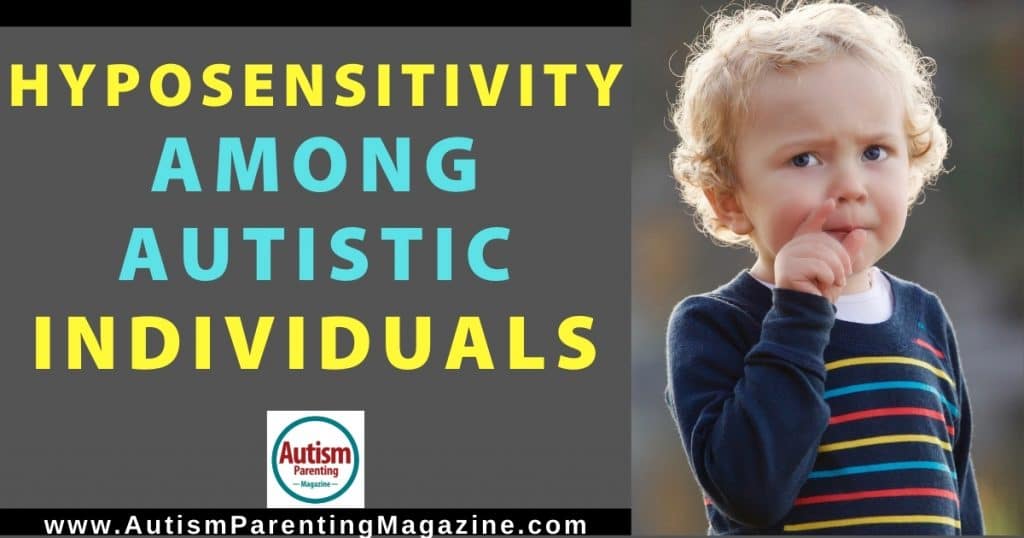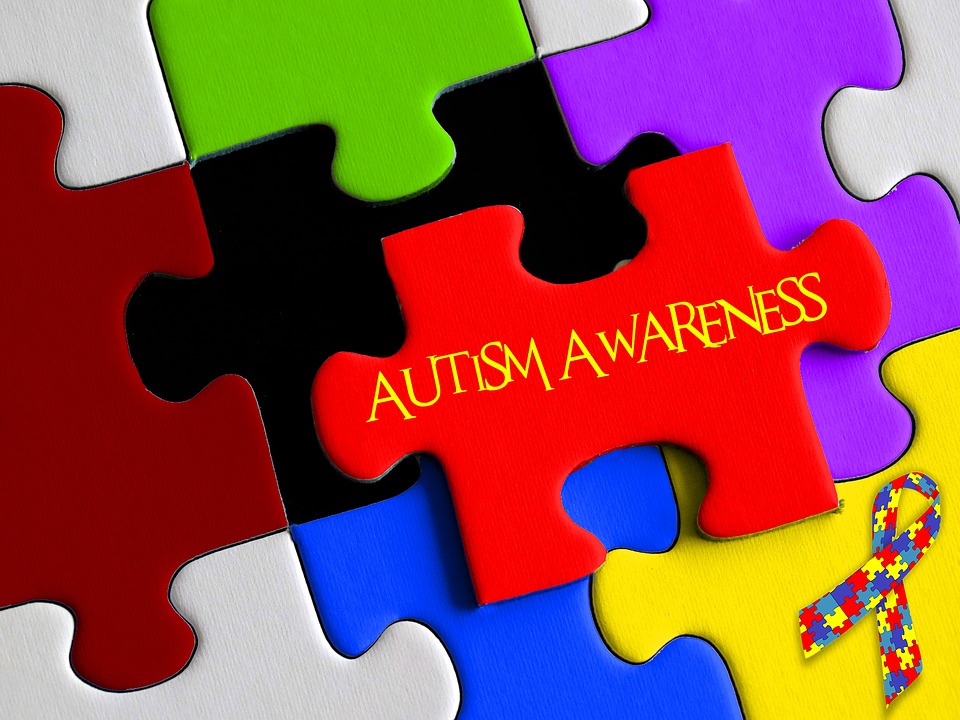When searching for information about your autistic child’s sensory challenges you may find many articles about hypersensitivity. But what about hyposensitivity, and the accompanying sensory seeking behavior of a child who finds the world an underwhelming place?

As research discovers more about the autistic brain, we can’t help but marvel at some of the skills and strengths that underlie the neurodivergent mind. One the other hand, research is also delving deeper into just how the deficits and symptoms of autism may lead to difficulties experienced in everyday life.
For those on the spectrum, sensory difficulties may be some of the most challenging symptoms to manage. According to the Diagnostic and Statistical Manual of Mental Disorders (5th ed.; DSM–5; American Psychiatric Association, 2013) hyper- or hyporeactivity to sensory input is one of the ways in which restricted, repetitive patterns of behavior may manifest.
Another core impairment of autism is communication. When you consider the reality of an autistic child’s life, with sensory difficulties and deficits in communication, it may be deduced that he/she might experience sensory challenges and lack the necessary communication skills to express such discomfort (for example a lack of tactile stimuli) with parents or caregivers.
A study (Leekman et al., 2007) revealed that over 90% of the participating children with autism had sensory abnormalities and symptoms in various sensory domains. These sensory abnormalities may impact many areas of the autistic child’s life—according to Thye et al. (2018) altered sensory processing and sensory integration (in autism) affect areas such as emotion, response to reward, language, communication, and other functions in those with autism spectrum disorders.
Identifying such sensory difficulties and seeking early intervention may help the autistic child deal with some of the challenges mentioned above. In this article, hyposensitivity will be examined and discerned from hypersensitivity.
Hyposensitivity vs hypersensitivity
We experience the world and interact with our environment through our eight senses. These eight senses or sensory systems (visual, auditory, tactile, olfactory, gustatory, introception, proprioception and vestibular system) collect information; but sometimes dysfunction in processing such sensory input occurs in individuals with a sensory processing disorder.
As the name indicates hypersensitivity is a hyper reaction (or overreaction) to sensory stimuli. Hypersensitivity is evident when a child has an extreme reaction to the sensory input in their environment. Difficult behavior or volatile emotions may be a response to lights, sounds, smells and touch— neutral sensory input that sends their nervous system into overdrive. Such kids do well with sensory aids like sunglasses and noise cancelling headphones.
Hyposensitivity is found at the other end of the sensitivity spectrum. Hyposensitivity occurs when an individual displays an under-sensitive reaction to sensory stimulation. It is entirely possible for a person to display hypersensitivity in some contexts and hyposensitivity in others. Hyposensitivity is often evident when there is extreme sensory seeking behavior to compensate for feeling underwhelmed.
Characteristics of hyposensitivity
Hyposensitivity falls under the umbrella term of sensory processing disorder—a neurological condition where an individual has an abnormal response to sensory input. In this sense, hyposensitivity is an “abnormal” response, as the reaction to sensory stimulation is under-responsive.
Signs of hyposensitivity
As many children on the spectrum struggle to express themselves, parents will have to seek clues in their behavior. Hyposensitivity is characterized by clumsiness, excessive fidgeting and trouble respecting personal space. A child may be express hyposensitivity in the following ways:
• Hyposensitivity to visual input
The child may tire easily from reading and schoolwork, he/she may have trouble seeing the big picture (instead may focus on details or patterns within), or difficulty locating objects (among others objects like grocery items in a pantry, or stationary on a desk)
• Hyposensitivity to audio input
The child may seek out sound, listening to music or tv at the loudest volume possible, or putting his/her ears right up to volume producing objects like speakers
• Hyposensitivity to olfactory and gustatory input
A child who frequently mouths or licks inedible objects, who prefers strong tastes and condiments with every meal, may be hyposensitive to taste
• Hyposensitivity to tactile input
These kids are sometimes mistaken for bullies because of their intense, sometimes hurtful touch, hugging too hard, crashing into people—touch has to be extreme for them to feel it. They may not feel pain and temperature like typical children do, and they may prefer rolling around on surfaces instead of just sitting or standing
• Hyposensitivity to proprioceptive input
The child may crash into furniture and struggle with navigating a room. He/she may have trouble balancing, stumble frequently and drop objects regularly
• Hyposensitivity to vestibular input
To make up for his/her vestibular hyposensitivity, the sensory seeking child might beg to be tossed in the air, swing for hours or spin for prolonged periods without dizziness
Children who are hyposensitive to sensory input are always seeking stimuli. Their behavior may annoy peers or appear strange, but behavior is simply aimed at regulating an under-reactive sensory system.
Autism and hyposensitivity
Although most children on the spectrum have a sensory processing disorder, it is difficult to determine the percentage of children who are over-responsive to sensory input vs those who are under-responsive with accuracy. This may be due to the fact there is no standardized method to determine or classify sensory difficulties or abnormalities in autistic individuals.
A study by Taylor et al. (2020) found greater hypersensitivity, but not hyposensitivity in females with autism spectrum conditions in comparison to control groups. The study also showed that a greater degree of autism traits correlates to higher hypersensitivity in autistic females.
Studies investigating whether autistic children are more likely to be hyper- or hyposensitive, and the impact of both conditions on behavior, would be useful. Many in the autism community lament the fact that sensory processing disorder is not recognized by mainstream medicine (or the DSM-5) as an official or separate diagnosis. There are appeals and scientific proposals that make a great case for inclusion of sensory processing disorder in the DSM-5.
It is clear that research pertaining to sensory processing difficulties in autistic individuals should be prioritized as sensory challenges are often at the root of challenging behavior and meltdowns. A study by Zachor and Ben-Itzchak (2013) indicates that “unusual sensory interests” is associated with more severe clinical presentation in aspects of functioning such as autism severity and cognitive abilities.
Solutions for sensory seekers
If your autistic child has behavioral challenges and you suspect it may be linked to sensory seeking behavior, an occupational or physical therapist could assist with diagnosis and appropriate therapies. Sensory integration therapy may be helpful in addition to exercises aimed at improving body awareness and balance.
Your therapist may also suggest sensory solutions for your home, where your child’s frequent quest for sensory experiences may cause difficulties. The kind of input your child craves depends on the exact nature of his/her sensory processing condition. For some kids, “heavy work” or activities requiring the use of muscles and joints (the activity’s movement should exert pressure on the muscle and joints) provides the kind of input they crave and need. For others simple solutions like snug fitting pajamas, weighted blankets or squishy stress balls provide relief.
In conclusion
Children with undiagnosed hyposensitivity will often struggle at school. If your child crashes into other students, or hugs them too tightly and ignores unwritten boundaries and personal space standards, he/she could be ostracized. Undeservedly so, because his/her behavior is probably unintentional and aimed at finding input to make up for a sensory system deficit or impairment.
If communicating was an autistic strength rather than a core deficit, kids struggling with an under-responsive sensory system could tell us exactly what they need to thrive. A differently wired brain, sensory processing difficulties and communication challenges, make expressing all this difficult—this is a reality for many children on the spectrum. Parents, with help from occupational and physical therapists, can help their child thrive by looking for signs and addressing his/her sensory processing disorder.
References:
American Psychiatric Association. (2013). Diagnostic and statistical manual of mental disorders (5th ed.). https://doi.org/10.1176/appi.books.9780890425596
Leekam, S. R., Nieto, C., Libby, S. J., Wing, L., & Gould, J. (2007). Describing the sensory abnormalities of children and adults with autism. Journal of autism and developmental disorders, 37(5), 894–910. https://doi.org/10.1007/s10803-006-0218-7
Taylor, E., Holt, R., Tavassoli, T. et al. Revised scored Sensory Perception Quotient reveals sensory hypersensitivity in women with autism. Molecular Autism 11, 18 (2020). https://doi.org/10.1186/s13229-019-0289-x
Thye, M. D., Bednarz, H. M., Herringshaw, A. J., Sartin, E. B., & Kana, R. K. (2018). The impact of atypical sensory processing on social impairments in autism spectrum disorder. Developmental cognitive neuroscience, 29, 151–167. https://doi.org/10.1016/j.dcn.2017.04.010
Zachor, D. A., & Ben-Itzchak, E. (2013). The Relationship Between Clinical Presentation and Unusual Sensory Interests in Autism Spectrum Disorders: A Preliminary Investigation. Journal of autism and developmental disorders, Advance online publication. https://doi.org/10.1007/s10803-013-1867-y
Source: Hyposensitivity Among Autistic Individuals – Autism Parenting Magazine













